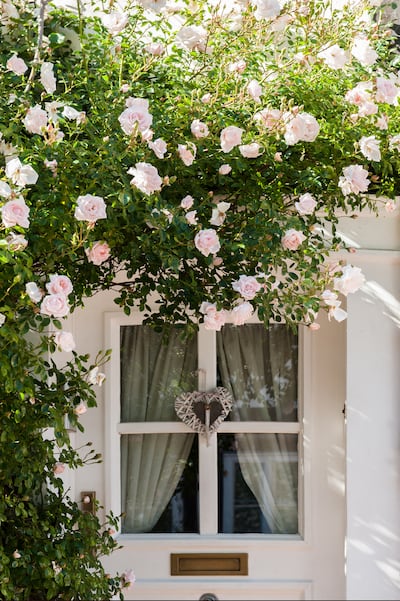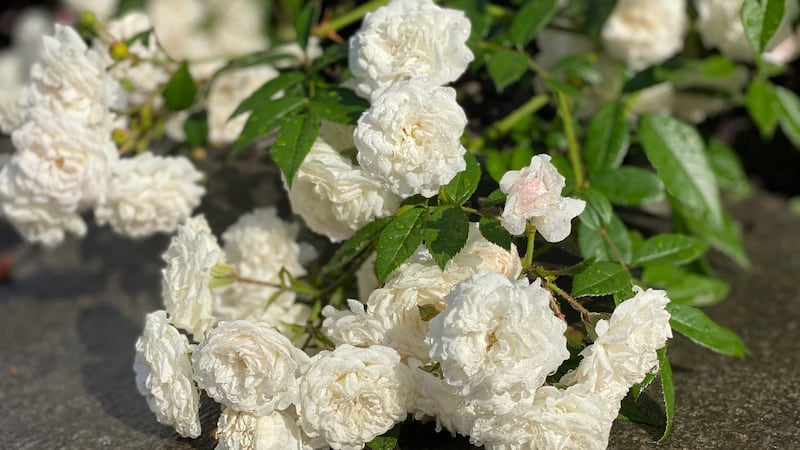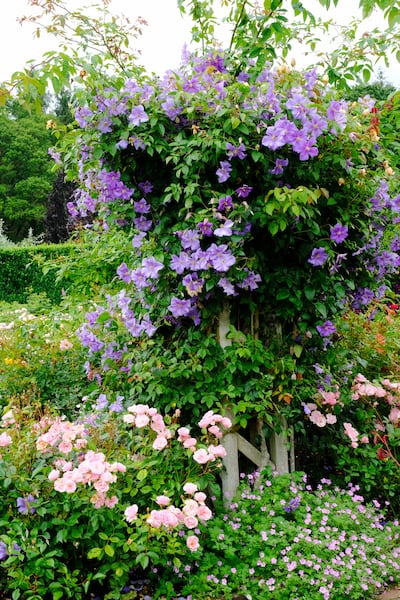They say there’s no such thing as the perfect couple. But when it comes to companionable, compatible planting, it’s fair to say climbing roses and clematis make a near-unbeatable combination. Like butter on toast, salty caramel or strawberries dipped in chocolate, some partnerships are made in heaven and these two climbers just get along famously well.
It helps, of course, that they like similar growing conditions, flourishing on a tall, bright, sheltered wall, pergola or fence that offers them shelter from cold, blustery winds. Both also like a fertile, moisture-retentive but free-draining, weed-free soil that’s been generously enriched with well-rotted manure and/or garden compost.
Like all great partnerships, they also complement each other’s strengths while mitigating each other’s weaknesses. The rose’s strong, thorny stems, for example, provide the perfect vertical scaffold for the clematis to clamber up, elegantly cloaking them as it does. That same canopy of thorny branches helps to shade the roots of the clematis from hot sunshine, something all clematis appreciate.

Clematis also offer a palette of colours not seen in roses; true blues and lavenders that combine very well with the pink, blush, apricot, yellow and cream tones of the latter. Chosen so that the clematis’s flowering period coincides with the rose or follows on from it, it’s a happy partnership that can be used to creating eye-poppingly beautiful displays in bloom throughout the summer and autumn months.
But therein lies the challenge that some would call the paradox of choice. Like children in a giant sweetshop, the number of clematis and climbing rose varieties now available to gardeners is so mind-bogglingly vast and the range so tantalising beautiful that it can be hard to whittle it down to a mere handful of varieties. So how do we go about choosing the most winning combinations in terms of flower colour, flower shape, growth habit and season of interest? Let’s start with a few pointers, most important of which is that of the vast genus of clematis, some are just not suitable for this sort of intimate horticultural tango.
Thuggish sprawlers such as Clematis montana and Clematis armandii, for example, need plenty of space to romp and are just too large and vigorous to pair with a climbing rose. Or smaller spring-flowering clematis with very different requirements regarding their pruning times that make it difficult to prune the climbing roses that they’re climbing through without causing damage to new growth. Or those species of clematis that generally don’t like to be pruned at all – an example is the lovely evergreen Clematis ‘Avalanche’ – which resent the inevitable disturbance caused by rose pruning.
Easy option
Instead, for ease of maintenance, it’s best to choose clematis that belong to what’s known in gardening parlance as group three, and whose flowering period overlaps with that of climbing roses. Not only can this group of clematis be pruned at the same time of year as climbing roses (winter/early spring), but critically, they also flower on fresh growth. This means their stems can and should be pruned right back to just above their lowest pair of buds, usually just 30cm or so above ground level, meaning there’s no faffing about trying to painstakingly protect their delicate stems while you prune a climbing rose’s thorny branches. Conveniently for gardeners, this large group also contains some of the loveliest and longest-flowering of all clematis.

Top of that list is the species known as Clematis viticella. Graceful, floriferous, long-flowering (July-September), hardy, drought-tolerant, disease-resistant, robust but not overly vigorous and happy to grow in the light shade of other climbers, it combines beautifully with climbing roses in a way that’s rarely gaudy. Outstanding varieties include the repeat-flowering Clematis ‘Etoile Violette’ (purple flowers); Clematis ‘Polish Spirit’ (violet-purple)’ Clematis ‘Walenburg (dainty two-toned flowers of dark pink and white); Clematis ‘Alba Luxurians’ (white); Clematis ‘Kermesina’ (bright red); Clematis ‘Purpurea Plena Elegans’ (small, red-purple double flowers), Clematis ‘Betty Corning (lilac blue)’ Clematis) and Clematis ‘Prince Charles’ (pale blue).
Clematis texensis is another late-flowering species from group three that’s suitable for planting in combination with climbing roses, producing its small, elegant, urn-shaped blooms generously from August until October. Varieties include ‘Princess Diana’ (bright pink); ‘Princess Kate’ (white/dusty pink-purple); ‘Prince William’ (deep violet-red) and Clematis ‘Etoile Rose’. Varieties of Clematis flammula will also associate well with the more vigorous varieties of climbing roses. Examples include the gorgeous ‘Clematis ‘Sweet Summer Love’.

Also within this group are some wonderful late, large-flowered hybrid varieties of clematis that flower from midsummer onwards such as ‘Huldine’ (white); violet-purple flowered ‘Lady Betty Balfour’, Clematis ‘Perle d’Azure’ (sky-blue) and Clematis ‘Jackmanii’ (purple-red). Not so suitable, however, are other very vigorous species of clematis from group three, which can easily overwhelm a climbing rose by stifling growth, stealing light and causing problems with disease. Examples of the latter include varieties of Clematis tangutica, rehderiana and terniflora.
Rose combination
Last but not least, bear in mind that when it comes to pairing clematis with climbing roses, you’re not necessarily limited to just one variety of the former. So for example, you could use a combination of a viticella-type along with one of the larger-flowered hybrids. That said, be wary of over-egging it. If in doubt, go for subtle combinations of colour (I personally think strongly-contrasting combinations can look a little dated) and concentrate on the smaller-flowered varieties, which feel more contemporary.

As for your choice of climbing rose, the selection is vast. But try to concentrate on repeat-flowering, floriferous, vigorous, disease-resistant, scented varieties. Examples include the dark crimson Rosa ‘Etoile de Hollande’; Rosa ‘Souvenir du Docteur Jamain’ (dark scarlet); Rosa ‘Climbing Iceberg’ (cream-white); Rosa ‘Gertrude Jekyll’ (rose-pink); Rosa ‘Teasing Georgia’ (deep yellow): Rosa ‘Graham Thomas’ (soft yellow); Rose ‘Schoolgirl’ (deep apricot); Rosa ‘Compassion’ (coral-pink); Rosa ‘Danse de Feu’ (bright red); (1.5 x 1.5m); Rosa ‘Penny Lane’ (apricot)’and Rose ‘Wollerton Old Hall’ (pale apricot).
April is a good time to plant both container-grown clematis and climbing roses, making sure to select strong, healthy plants free of disease or damage. Prepare the soil well in advance by digging a generous-sized hole and working in lots of well-rotted manure and/or home-made compost and some slow-release organic fertiliser. Make sure to space the pre-soaked root-ball of each plant 45cm-60cm apart, matching the finished planting depth to when the plant was growing in its pot and then finishing with a generous watering. Bear in mind that climbing roses need some form of strong support, whether that’s horizontal tiers of garden wire secured to screws or a metal grid fixed to the wall. It’s also important to water newly planted specimens regularly in dry periods until they establish.
THIS WEEK IN THE GARDEN
Sow seed of half-hardy annuals as soon as possible to guarantee strong, healthy plants, ready for transplanting out into the garden or allotment by the end of May. Half-hardy annuals won’t tolerate any degree of frost, so sow the seed under cover and with gentle heat into trays or pots filled with a good quality, damp seed compost. Cover with a transparent lid or plastic bag to seal in heat and humidity. Half-hardy plants suitable for sowing in late April include cosmos, Rudbeckia hirta, annual phlox, tagetes, courgettes, French beans and pumpkins.
As temperatures rise, slug populations will start to rapidly increase, quickly causing damage to the soft shoots of perennials and emerging seedlings. To control slug damage organically without resorting to conventional slug pellets, practise good garden hygiene and be vigilant. Keep a careful eye out for early signs of damage and search nearby for the offenders (the base of pots and trays are classic hideouts), using a sharp secateurs to snip any slugs you find in half. For the same reason, keep the grass around polytunnels, glasshouses and vulnerable beds strimmed/cut low. Very vulnerable trays of seedlings and transplants are best kept at a height on a table or bench.
DATES FOR YOUR DIARY
Saturday, 23rd April, (11am-2pm): RHSI Annual Plant Sale, Pembroke Lodge, Dargle Lane, Bray, Co Wicklow. Please note that this is a correction to last week's notice of the same event, which gave the incorrect location and time. rhsi.ie
Saturday April 30th (1.30pm-4pm): the Alpine Garden Society's Annual Show, Cabinteely Community School, Johnstown Road, Cabinteely, Co Dublin. alpinegardensociety.ie
Friday April 29th- May 1st: Garden Show Ireland, with talks and contributions by many well-known gardeners including Diarmuid Gavin, Klaus Laitenberger, Geoff Stebbings and flower farmers Aisling & Andy McCormick of Sow Grateful plus flower arranging displays by members of the Northern Ireland Group of Flower Arrangement Societies, Antrim Castle Gardens, Randalstown Road, Antrim. gardenshowireland.com












